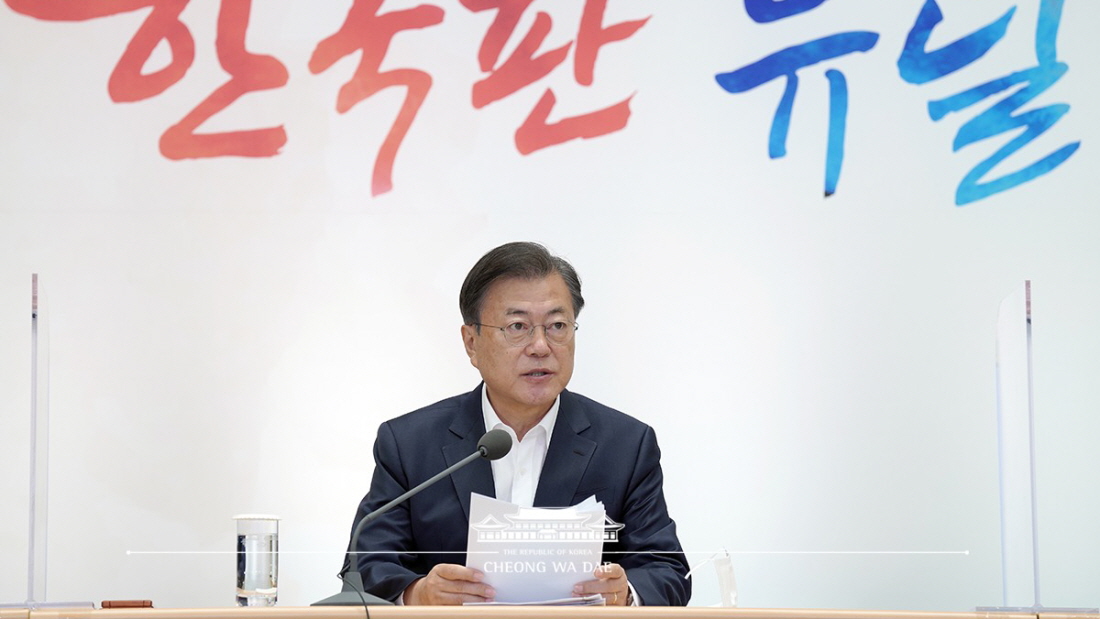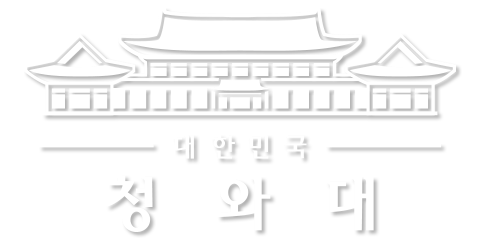이 웹사이트는 제19대 대통령 임기 종료에 따라 대통령기록관이 「대통령기록물 관리에 관한 법률」에 의해 이관받아 서비스하는 대통령기록물입니다. 자료의 열람만 가능하며 수정 · 추가 · 삭제는 불가능합니다.
다만, 「개인정보보호법」에 의하여 개인의 정보를 보호받기 원하시는 분은 관련 내용(요청자, 요청내용, 연락처, 글위치)을 대통령 웹기록물 담당자(044-211-2253)에게 요청해 주시면 신속히 검토하여 조치해 드리겠습니다. 감사합니다.
SPEECHES & REMARKS
BRIEFINGS
Opening Remarks by President Moon Jae-in at 2nd Strategy Meeting for Korean New Deal

I am very pleased to meet the mayors and provincial governors gathered here together who are at the forefront of the efforts to fight COVID-19 and overcome the economic crisis. Aggressive and dedicated actions by local governments serve as a catalyst for the success of Korea’s response to COVID-19 and the efforts to surmount difficulties in people’s livelihoods and the economy. I am deeply grateful to the mayors and provincial governors as well as civil servants working at local governments for their hard work.
Along with efforts to prevail over this crisis, we cannot afford to waste a moment and break our stride as we strive to usher in the Republic of Korea’s future and achieve the dream of balanced national development. Envisioning a bold initiative for balanced regional development, the Government intends to make a strong drive for the Korean New Deal as a national development strategy for the future of the Republic of Korea. It means we will shift the axis of national development and pivot toward local areas.
To give the initiative a more concrete structure, we will add the “Regionally Balanced New Deal” to the other fundamental spirits of the Korean New Deal: a robust safety net, the Digital New Deal and the Green New Deal. This represents the Government’s strong intention to dynamically transform the Republic of Korea, starting with its localities.
For implementation of the Regionally Balanced New Deal to succeed, it is imperative that the central and local governments and the private sector participate and work together. Support from the National Assembly is also needed. For this reason, we have convened this 2nd strategy meeting for the Korean New Deal as a joint meeting, bringing together mayors and governors to discuss the topic of the Regionally Balanced New Deal. Relevant ministers, the Chairperson of the Presidential Committee on Autonomy and Decentralization and the Chairperson of the Presidential Committee for Balanced National Development are with us today as well.
Also present here from the National Assembly, in a bid to provide responsible support, are the floor leader, the Policy Committee Chairperson and the K-New Deal Committee Chair from the ruling party. I am grateful to you all for attending this meeting despite your busy schedules.
The Government has vigorously pushed ahead with the policies for balanced national development: innovative cities, large-scale relevant projects, the designation of special regulation-free zones, the expansion of neighborhood infrastructure in local areas, fiscal decentralization and projects to create mutually beneficial local jobs. The Regionally Balanced New Deal will further invigorate and improve the balanced national development policies that have been implemented thus far. In addition, this New Deal constitutes a regional innovation strategy that changes and revitalizes local areas.
First, the Regionally Balanced New Deal will help make the Korean New Deal tangible – starting in local areas – thereby changing residents’ lives.
More than 75 trillion won – or about half of the total 160 trillion won to be invested under the Korean New Deal master plan – is earmarked for regional projects. Green smart schools, smart green industrial complexes, green remodeling and other representative Korean New Deal projects will innovate living and work spaces as well as change people’s lives. I expect that they will make significant contributions to revitalizing local economies and creating jobs.
Second, the Regionally Balanced New Deal will help local areas generate creative development models. If these local initiatives are enhanced further, this New Deal will become a venue that allows people in those areas to fully exert their creativity and imagination as key players. I believe there will be many achievements and excellent models if local governments take the lead and businesses and residents cooperate. Pushing the Regionally Balanced New Deal at the pan-regional level through cooperation among neighboring local governments is also an ideal way to enhance competitiveness.
Third, the Regionally Balanced New Deal will refine balanced development in conjunction with existing balanced national development initiatives. Innovative cities will become hubs for the Regionally Balanced New Deal. Large-scale balanced national development projects already underway will become more sophisticated once combined with the Digital New Deal and the Green New Deal. Projects to build neighborhood infrastructure tailored to the needs of local areas will be combined with the Korean New Deal and help further improve local residents’ quality of life.
I hope that the Regionally Balanced New Deal will help my Administration’s balanced development policies advance to a new level. The Government will strongly push ahead with the Regionally Balanced New Deal, believing that the success of the Korean New Deal is riding on it. We will provide as much financial support as possible, for instance, by actively attaching incentives to Regionally Balanced New Deal projects. We will also aggressively improve the relevant systems to efficiently push the Regionally Balanced New Deal.
We will pay special attention and direct all available assistance to creative local projects, including those formed by pan-regional groupings. We will also establish robust cooperative systems that strengthen communication and collaboration between the central and local areas.
Today, we are taking the first step to launch the Regionally Balanced New Deal. It is now a fundamental spirit of the Korean New Deal and at the center of the balanced national development program. I ask the central and local governments and the private sector to join forces to vigorously and swiftly set it in motion. I look forward to the next joint meeting of mayors and governors being a venue to assess and share the progress and results of the Regionally Balanced New Deal.
Thank you.



